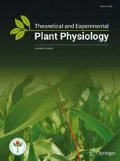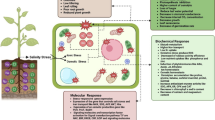Abstract
The effects of UV-B irradiation and Biomin (a natural substance extracted from coal with active ingredients of humic acids) on the content of endogenous polyamines spermine, spermidine and putrescine, and free amino acids in shoots and roots of young triticale seedlings were investigated. Biomin was added to the nutrient medium 3 days prior to UV-B irradiation. The seedlings were treated with 7.7 kJ m−2 day−1 UV-B light for 4 days. The exposure to UV-B increased total free amino acids, while Biomin application alone did not affect considerably their content. The treatment with UV-B or Biomin alone provoked augmentation of conjugated and bound polyamine (PA) fractions. Data suggest that Biomin alleviates the negative consequences of UV-B stress, manifested by the normalized amino acid and polyamine amounts in the UV-B + Biomin-treated plants. This study demonstrates the protective effect of Biomin on triticale plants against UV-B irradiation, which could be related to alterations in PAs and amino acids pools.






Similar content being viewed by others
References
An LZ, Liu GX, Zhang MX et al (2004) Effect of enhanced UV-B radiation on polyamine content and membrane permeability in cucumber leaves. Russ J Plant Physiol 51(5):658–662
Anjum AA, Gill SS, Khan I, Gill R (2014) Environmental change, and plant amino acids and their derivatives—an introduction. In: Anjum NA, Gill SS, Gill R (eds) Plant adaptation to environmental change. Significance of amino aids and their derivatives. CAB International, Oxfordshire, pp 1–17
Asli S, Neumann PM (2010) Rhizosphere humic acid interacts with root cell walls to reduce hydraulic conductivity and plant development. Plant Soil 336:313–322
Azevedo RA, Lancien M, Lea PJ (2006) The aspartic acid metabolic pathway, an exciting and essential pathway in plants. Amino Acids 30:143–162
Bates L, Waldren R, Teare I (1973) Rapid determination of free proline for water-stress studies. Plant Soil 39:205–207
Björn LO (2015) On the history of phyto-photo UV science (not to be left in skoto toto and silence). Plant Physiol Biochem 93:3–8
Bouchereau A, Aziz A, Larher F et al (1999) Polyamines and environmental challenges: recent development. Plant Sci 140:103–125
Caldwell MM (1971) In: Giese AC (ed) Solar ultraviolet radiation and the growth and development of higher plants, photophysiology, vol 6. Academic Press, New York, pp 131–177
Canellas LP, Olivares FL, Aguiar NO et al (2015) Humic and fulvic acids as biostimulants in horticulture. Sci Hortic 196:15–27
Chen Y, Aviad T (1990) Effects of humic substances on plant growth. In: MacCarthy P, Clapp C, Malcom R et al (eds) Humic substances in soils and crop science: selected readings. Soil Science Society of America, Madison, pp 161–186
Chen Y, Clapp C, Magen H (2004a) Mechanism of plant growth stimulation by humic substances: the role of organo-iron complexes. Soil Sci Plant Nutr 50:1089–1095
Chen Y, De Nobili M, Aviad T (2004b) Stimulatory effects of humic substances on plant growth. In: Magdoff F, Weil R (eds) Soil organic matter in sustainable agriculture. CRC Press, Boca Raton, pp 103–129
Cia MC, Guimarães ACR, Medici LO et al (2012) Antioxidant responses to water deficit by drought-tolerant and -sensitive sugarcane varieties. Ann Appl Biol 161(3):313–324
Day TA, Vogelmann TC, DeLucia HE (1992) Are some plant life forms more effective than others in screening out ultraviolet-B radiation? Oecologia 92:513–519
Diaz P, Betti M, Garcia-Calderon M et al (2014) Amino acids and drought stress in lotus: use of transcriptomics and plastidic glutamine synthetase mutants for new insights in proline metabolism. In: Anjum NA, Gill SS, Gill R (eds) Plant adaptation to environmental change. Significance of amino aids and their derivatives. CAB International, Oxfordshire, pp 53–67
El Meskaoui A, Trembaly FM (2009) Effects of exogenous polyamines and inhibitors of polyamine biosynthesis on endogenous free polyamine contents and the maturation of white spruce somatic embryos. Afr J Biotechnol 8(24):6807–6816
Fariduddin Q, Varshney P, Yusuf M et al (2013) Polyamines: potent modulators of plant responses to stress. J Plant Interact 8(1):1–16
Galili G, Tang G, Zhu X et al (2001) Lysine catabolism: a stress and development super-regulated metabolic pathway. Curr Opin Plant Biol 4:261–266
García AC, Santos LA, Izquierdo FG et al (2014) Potentialities of vermicompost humic acids to alleviate water stress in rice plants (Oryza sativa L.). J Geochem Explor 136:48–54
Gill SS, Tuteja N (2010) Polyamines and abiotic stress tolerance. Plant Signal Behav 5:26–33
Groppa MD, Benavides MP (2008) Polyamines and abiotic stress: recent advances. Amino Acids 34(1):35–45
Habibi G (2012) Exogenous salicylic acid alleviates oxidative damage of barley plants under drought stress. Acta Biol Szeged 56:57–63
Kabiri R, Farahbakhsh H, Nasibi F (2012) Salicylic acid ameliorates the effects of oxidative stress induced by water deficit in hydroponic culture of Nigella sativa. J Stress Physiol Biochem 8:13–22
Kamenova-Jouhimenko S, Markovska Y, Georgieva V (1997) Effects of biomin and algae suspensions on the activities of carboxylating and decarboxylating enzymes in cadmium-treated pea plants. Biol Plant 40:405–410
Kamenova-Jouhimenko S, Georgieva V, Khristov Kh (2003) Protective action of humic acids against cadmium toxicity in pea plants. Plant Sci 40:283–287 (in Bulgarian)
Katerova Z, Todorova D (2009) Endogenous polyamines lessen membrane damages in pea plants provoked by enhanced ultraviolet-C radiation. Plant Growth Regul 57:145–152
Kramer G, Norman H, Krizek D et al (1991) Influence of UV-B radiation on polyamines, lipid peroxidation and membrane lipids in cucumber. Phytochemistry 30:2101–2108
Kramer G, Krizek D, Mirecki R (1992) Influence of photosynthetically active radiation and spectral quality on UV-B-induced polyamine accumulation in soybean. Phytochemistry 31:1119–1125
Kulikova NA, Stepanova EV, Koroleva OV (2005) Mitigating activity of humic substances: direct influence on biota. In: Perminova IV, Hatfield K, Hertkorn N (eds) Use of humic substances to remediate polluted environment: from theory to practice. Springer, Netherlands, pp 285–309
Kuznetsov VV, Shevyakova NI (1999) Proline under stress: biological role, metabolism, and regulation. Russ J Plant Physiol 46:274–289
López-Serrano L, Penella C, San Bautista A et al (2017) Physiological changes of pepper accessions in response to salinity and water stress. Span J Agric Res 15(3):e0804
Lütz C, Navakoudis E, Seidlitz H et al (2005) Stimulated solar irradiation with enhanced UV-B adjust plastid- and thylakoid-associated polyamine changes for UV-B protection. Biochim Biophys Acta 1710:24–33
Mapelli S, Brambilla I, Bertani A (2001) Free amino acids in walnut kernels and young seedlings. Tree Physiol 21:1299–1302
Mapelli S, Shorina M, Brambilla I et al (2006) Biochemical and physiological events following exposure to UV-B radiation in ice plants. Genet Appl Plant Physiol 32(1–2):33–44
Mapelli S, Brambilla IM, Radyukina NL et al (2008) Free and bound polyamines changes in different plants as a consequence of UV-B light irradiation. Genet Appl Plant Physiol 34(1–2):55–66
Martin-Tanguy J (2001) Metabolism and function of polyamines in plants: recent development (new approaches). Plant Growth Regul 100:675–688
Moore S (1968) Amino acid analysis: aqueous dimethyl sulfoxide as solvent for the ninhydrin reaction. J Biol Chem 243:6281–6283
Mora V, Bacaicoa E, Zamarreno A-M et al (2010) Action of humic acid on promotion of cucumber shoot growth involves nitrate-related changes associated with the root-to-shoot distribution of cytokinins, polyamines and mineral nutrients. J Plant Physiol 167:633–642
Nardi S, Pizzeghello D, Muscolo A et al (2002) Physiological effects of humic substances on higher plants. Soil Biol Biochem 34:1527–1536
Okumoto S, Pilot G (2011) Amino acid export in plants: a missing link in nitrogen cycling. Mol Plant 4(3):453–463
Pandey M, Srivastava AK, Suprasanna P et al (2012) Thiourea mediates alleviation of UV-B stress-induced damage in the Indian mustard (Brassica juncea L.). J Plant Inter 7:143–150
Park E-J, Jeknić Z, Chen THH (2006) Exogenous application of glycinebetaine increases chilling tolerance in tomato plants. Plant Cell Physiol 47:706–714
Quaite EF, Sutherland BM, Sutherland JC (1992) Action spectrum for DNA damage in alfalfa lowers predicted impact of ozone depletion. Nature 358:576–578
Ramesh SA, Tyerman SD, Xu B et al (2015) GABA signalling modulates plant growth by directly regulating the activity of plant-specific anion transporters. Nat Commun 6:7879
Sergiev I, Todorova D, Moskova I et al (2013) Protective effect of humic acids against heavy metal stress in triticale. Compt Rend Acad Bulg Sci 66:53–60
Sergiev I, Todorova D, Brankova L et al (2016) Prohexadione-Ca and copper effect on growth and accumulation of endogenous polyamines in pea plants. Botanica Lithuanica 22:65–71
Sergiev I, Todorova D, Shopova E et al (2017a) Auxin-like compounds act as protectors against UV-B irradiation in garden pea plants. Bot Lithuan 23(2):79–88
Sergiev I, Todorova D, Katerova Z et al (2017b) Beneficial effects of auxin-like compounds on pea plants irradiated with UV-C. Genet Plant Physiol 7(3–4):135–146
Silveira V, Santa-Catarina C, Tun NN et al (2006) Polyamine effects on the endogenous polyamine contents, nitric oxide release, growth and differentiation of embryogenic suspension cultures of Araucaria angustifolia (Bert.) O. Ktze. Plant Sci 171:91–98
Smith T, Best G (1977) Polyamines in barley seedlings. Phytochemistry 16:841–843
Smith J, Burritt D, Bannister P (2001) Ultraviolet-B radiation leads to a reduction in free polyamines in Phaseolus vulgaris L. Plant Growth Regul 35:289–294
Stapleton AE (1992) Ultraviolet radiation and plants: burning questions. Plant Cell 4:1353–1358
Szabados L, Savouré A (2010) Proline: a multifunctional amino acid. Trends Plant Sci 15(2):89–97
Takeuchi Y, Kubo H, Kasahara H et al (1996) Adaptive alterations in the activities of scavengers of avtive oxygen in cucumber cotyledons irradiated with UV-B. J Plant Physiol 147:589–592
Teramura AH (1983) Effects of ultraviolet-B radiation on the growth of yield of crop plants. Plant Physiol 58:415–427
Teramura AH, Sullivan JH (1994) Effects of UV-B radiation on photosynthesis and growth of terrestrial plants. Photosynth Res 39:463–473
Todorova D, Sergiev I, Alexieva V et al (2007) Polyamine content in Arabidopsis thaliana (L.) Heynh during recovery after low and high temperature treatments. Plant Growth Regul 51:185–191
Todorova D, Moskova I, Sergiev I et al (2008) Changes in endogenous polyamines and some stress markers content induced by drought, 4PU-30 and abscisic acid in wheat plants. In: Khan N, Singh S (eds) Abiotic stress and plant responses. International Publishing House, New Delhi, pp 205–215
Todorova D, Katerova Z, Shopova Z et al (2013) Polyamine spermine protects young pea plants against ultraviolet-C radiation. Biotechnol Biotechnol Eq 27(3):3798–3802
Todorova D, Sergiev I, Moskova I et al (2014) Biochemical responses of triticale plants treated with UV-B irradiation and nutrient solution enriched with humic acids. Turk J Bot 38:747–753
Todorova D, Katerova Z, Sergiev I et al (2015) Polyamines—possibilities for application to increase plant tolerance and adaptation capacity to stress. Genet Plant Physiol 5(2):123–144
Torrigiani P, Altamura M, Copitani F et al (1989) De novo root formation in thin cell layers of tobacco: changes in free and bound polyamines. Physiol Plant 77:294–301
Young CC, Chen LF (1997) Polyamines in humic acid and their effect on radical growth of lettuce seedlings. Plant Soil 195:143–149
Zandonadi DB, Canellas LP, Facanha AR (2007) Indolacetic and humic acids induce lateral root development through a concerted plasmalemma and tonoplast H+ pumps activation. Planta 225:1583–1595
Zhang L, Gao M, Zhang L et al (2013) Role of exogenous glycinebetaine and humic acid in mitigating drought stress-induced adverse effects in Malus robusta seedlings. Turk J Bot 37:920–929
Zlatev Z, Lidon FJC, Kaimakanova M (2012) Plant physiological responses to UV-B radiation. Emir J Food Agric 24(6):481–501
Acknowledgements
This study was partially funded by the Bulgarian Science Fund, project DMU 03/60. The authors gratefully acknowledge Asya Nikolova and Nina Georgieva from the IPPG-BAS for their excellent technical assistance.
Author information
Authors and Affiliations
Corresponding author
Rights and permissions
About this article
Cite this article
Sergiev, I., Todorova, D., Katerova, Z. et al. Polyamines and amino acids in triticale plants grown on humic acids enriched nutrient solution and treated with UV-B irradiation. Theor. Exp. Plant Physiol. 30, 153–163 (2018). https://doi.org/10.1007/s40626-018-0110-9
Received:
Accepted:
Published:
Issue Date:
DOI: https://doi.org/10.1007/s40626-018-0110-9




